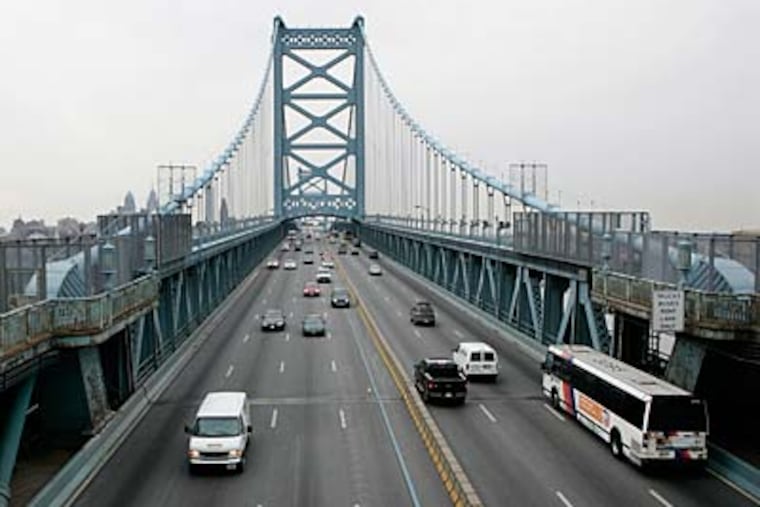Bridge use likely to fall further with toll hike
The number of paying customers on four Delaware River toll bridges, already at its lowest in a decade, is likely to fall further if a planned toll increase is approved this week.

The number of paying customers on four Delaware River toll bridges, already at its lowest in a decade, is likely to fall further if a planned toll increase is approved this week.
Traffic is down about 1 percent this year from 2009, after falling 5 percent a year earlier. Traffic had been rising each year since 2000, until tolls were increased by $1 for cars in September 2008, on the Ben Franklin, Walt Whitman, Commodore Barry, and Betsy Ross bridges operated by the Delaware River Port Authority.
And the DRPA's proposed 2011 budget anticipates that another $1 hike - to $5 - in the round trip car toll planned for next July will further reduce traffic. (The budget assumes toll revenues will rise by 11.39 percent if a 25 percent toll hike is imposed on July 1, less than if ridership remained constant.)
When the agency raised tolls in 2008, DRPA analysts predicted higher tolls could produce a 3 percent to 5 percent drop in traffic.
Some of the DRPA's lost ridership is thought to be using other, cheaper bridges, such as the Tacony-Palmyra span, which costs $2 per car. Other motorists may be skipping discretionary trips between Philadelphia and South Jersey, and, with unemployment up, some commuters are staying home because they're out of work.
And some commuters may be switching to PATCO trains, where ridership is up slightly for the year: Through September, PATCO's passenger count was up 27,568 (0.37 percent), compared to the same nine-month period in 2009.
A DRPA board committee on Wednesday will consider postponing the toll increase through 2011. It will also consider delaying a 10 percent increase in PATCO fares that is scheduled to take effect Jan. 1.
As they contemplate the planned increases, DRPA board members find themselves caught between the conflicting demands of commuters and Wall Street.
Cash-strapped commuters - and some of their elected representatives - have urged the DRPA not to raise tolls and fares in the current economic climate.
Financial analysts, though, have warned that putting off a toll increase could prompt bond-rating firms to downgrade DRPA's financial rating. That could lead to a default on finance instruments known as "swaps" and allow lender UBS to demand immediate payment of $220 million.
Last week, the DRPA finance committee looked at trimming the agency's operating budget for next year, cutting back on its $1 billion, five-year construction plan, and redirecting some unspent "economic development" funds to keep fares and tolls at current levels through 2011.
But, faced with the warnings from financial advisers, the committee put off a decision until Wednesday on a resolution by board member and Philadelphia labor leader John "Johnny Doc" Dougherty to postpone the toll increase until 2012.
Dougherty and fellow board member Pennsylvania Auditor General Jack Wagner have called for the DRPA to use unspent economic-development money to replace the revenue anticipated from a toll increase.
The DRPA has more than $50 million in unspent economic-development funding, and about $28 million of that is not contractually obligated for projects. That $28 million would provide as much revenue as six months of a $1 toll increase.
Pennsylvania state Sen. John C. Rafferty Jr. (R., Montgomery), chairman of the Senate Transportation Committee, also has asked the DRPA to use unspent economic development money to delay the toll hike.
In a letter to the DRPA board members, Rafferty said he considered it "unconscionable" that about 47 percent of the agency's toll revenue is used to repay debt, much of it "issued for such projects as professional sports stadiums, performing arts centers, and other local attractions."
In the last 12 years, the DRPA has spent about $500 million on such economic-development projects, contributing significantly to its total debt of $1.4 billion.
"Although these projects may have merit, it is not the responsibility of the users of DRPA bridges and PATCO to fund them," Rafferty wrote.
"The time has come to end the practice of funding projects outside of DRPA's core mission on the backs of those who use its bridges and ride its commuter trains. If utilizing the $28 million in unspent, uncommitted economic development funds will defer a toll increase for even a short period of time, I endorse that course of action."
Even with declining traffic, higher tolls would mean more revenue for the DRPA, since the 25 percent toll increase would outweigh the expected drop in traffic. And DRPA officials hope that a rebounding economy eventually will mean rebounding traffic counts, as well.
Financial analysts see additional revenue as crucial to maintaining investor confidence and allowing the DRPA to proceed with its $1 billion, five-year construction plan for repairing bridges, rebuilding PATCO railcars, and other projects.
Moody's Investors Service, which lowered its credit outlook for the DRPA to "negative" from "stable" after the agency first postponed the toll increase last December, wrote: "The postponement in additional toll increases will be an important factor in the rating moving forward, given the size of the anticipated capital program and the revenues needed to support such a large program."
Analysts at Standard & Poor's, another major financial-rating service, have been less concerned about the prospect of a postponed toll increase, as long as revenues keep pace with debts.
Moody's and Standard & Poor's rate the DRPA's debt at their fourth-lowest investment grades, A3 and A-, respectively.
The DRPA meeting, open to the public, will be 9 a.m. Wednesday at One Port Center in Camden, adjacent to the Adventure Aquarium.